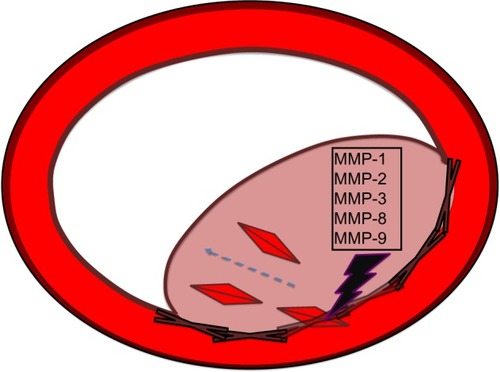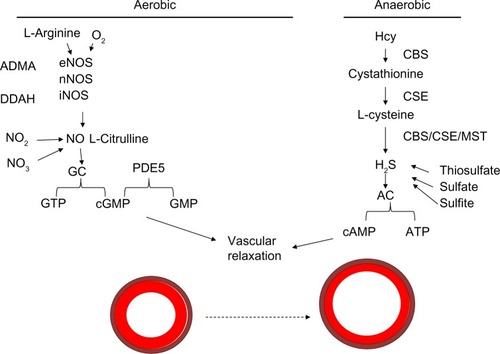Figures & data
Figure 1 MMPs and smooth-muscle cell proliferation.
Notes: MMP-1, -2, -3, -8, and -9 have been shown to be involved in facilitating vascular remodeling by degrading the matrix separating the intima from the media and allowing smooth-muscle cell migration from the media to the intima. This smooth-muscle cell migration results in the occlusion of vessel walls and decreased blood flow to tissues in need of oxygen and nutrients carried by the blood.
Abbreviation: MMP, matrix metalloproteinase.
Abbreviation: MMP, matrix metalloproteinase.

Figure 2 MMP-10 as clot destroyer in atherosclerosis.
Notes: LDL molecules and monocytes, including macrophages and T-cells, transcend the endothelial layer of the intima of blood vessels via transporters like VCAM-1. Macrophages within the intima will engulf oxidized LDL molecules and form foam cells. T-cells will release inflammatory cytokines, such as TNFα and IFNγ, that recruit molecules further into the intima. Smooth-muscle cells also proliferate into the intima layer from the media layer, which results in further occlusion of vessels. MMP-10 attacks the fibrinogen molecule and prevents its conversion to fibrin, which allows for the netting of platelets and resultant plaque occlusion.
Abbreviations: IFN, Interferon; LDL, low-density lipoprotein; M, macrophage; MMP, matrix metalloproteinase; T, T lymphocyte; TNF, tumor necrosis factor; VCAM-1, vascular cell adhesion molecule.
Abbreviations: IFN, Interferon; LDL, low-density lipoprotein; M, macrophage; MMP, matrix metalloproteinase; T, T lymphocyte; TNF, tumor necrosis factor; VCAM-1, vascular cell adhesion molecule.

Figure 3 Mechanism of vasodilation.
Notes: H2S can be acquired via various conversion steps of Hcy in an anaerobic pathway. Hcy is converted to cystathionine by CBS and then to L-cysteine by the CSE enzyme. L-Cysteine can be converted to H2S, which is used by adenylyl cyclase to convert ATP to cAMP involved in vasorelaxation. The substrates oxygen and L-arginine are known to be used by eNOS, nNOS, and iNOS enzymes to produce nitric oxide, which potentiates guanylyl cyclase to convert GTP to cGMP. cGMP is a molecule that allows for vascular relaxation. PDE5 inhibits vasorelaxation, as its activation converts cGMP to GMP and potentiates vasoconstriction.
Abbreviations: Hcy, homocysteine; CBS, cystathionine β-synthase; CSE, cystathionine γ-lyase; ATP, adenosine triphosphate; cAMP, cyclic adenosine monophosphate; eNOS, endothelial nitric oxide synthetase; nNOS, neuronal NOS; iNOS, inducible NOS; GTP, guanosine triphosphate; cGMP, cyclic guanosine monophosphate; PDE, phosphodiesterase; ADMA, asymmetric dimethylarginine; DDAH, dimethylarginine dimethylaminohydrolase; MST, 3-mercaptopyruvate sulfurtransferase; GC, guanylyl cyclase; AC, adenylyl cyclase.
Abbreviations: Hcy, homocysteine; CBS, cystathionine β-synthase; CSE, cystathionine γ-lyase; ATP, adenosine triphosphate; cAMP, cyclic adenosine monophosphate; eNOS, endothelial nitric oxide synthetase; nNOS, neuronal NOS; iNOS, inducible NOS; GTP, guanosine triphosphate; cGMP, cyclic guanosine monophosphate; PDE, phosphodiesterase; ADMA, asymmetric dimethylarginine; DDAH, dimethylarginine dimethylaminohydrolase; MST, 3-mercaptopyruvate sulfurtransferase; GC, guanylyl cyclase; AC, adenylyl cyclase.

